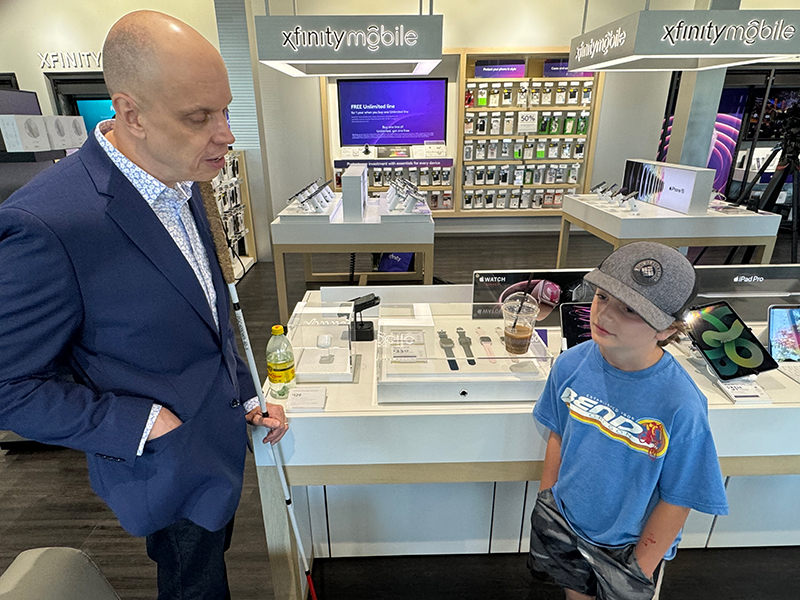As Tom Wlodkowski walked through San Francisco Airport on his way to a conference, people frequently approached him, asking if he needed help.
Blind since birth and using a cane, he continued navigating the complex maze of the airport, a challenge even for someone with sight, while declining offers of assistance.
“No, thanks,” he told them. “I’ve got it.”
His tool was an iPhone, on which other sighted people were looking at the maze and guiding him step by step.
“Technology has been the great equalizer,” he said in an interview. “The iPhone has been a great invention for us.”
Wlodkowski is a huge inspiration at Comcast. As the vice president in charge of accessibility, his career is devoted to making sure people with limited abilities can be a part of a world too often designed for those with no limits.
“We borrow a phrase from the Civil Rights movement,” he says. “Nothing about us without us.”
And he’s living proof of the expression.
My 9-year-old asks him a burning question.
“Do you watch movies?”
“Yes, I love them,” Tom answers.
“How?” my inquisitive second grader asks.
“There are subtle voice overs that describe the scenes, the character’s age, what they are wearing or what is happening on screen when no one is talking,” explains Tom, who was the youngest of four kids raised in Connecticut.
And yes, he watched “Spider-man” and a slew of Marvel movies with his own kids.
Tom’s team was also the driving force behind Comcast’s recent move to bring American Sign Language support for the deaf into its Bay Area Xfinity retail stores. A deaf or hard of hearing customer can use this new ASL service to shop, check their account, pay a bill or any of the same things that a hearing person is able to do.
Some other steps forward include bills in Braille and in large print and remote controls with large type and large buttons for those with limited mobility.
There are Bluetooth hearing aids to make it easier for those with hearing problems to watch their favorite shows. There’s hands-free software that lets viewers control the television with their words.
There’s also a remarkable invention that lets people control TV screens with eye movements!
You can access information about these devices here: xfinity.com/accessibility
Tom’s parents chose to mainstream him in school, rather than sending him to a school for the blind.
“I was expected to do whatever everyone else did,” he says. “Certainly there were adaptations, but the expectations were the same for me as they were for my three older brothers.”
A graduate of Boston College, he worked as the Director of Accessibility at AOL for over 10 years and also held positions at the WGBH Media Access Group, home to the Descriptive Video Service, Caption Center and the National Center for Accessible Media.
Under Tom’s leadership, Comcast launched Voice Guidance on Xfinity X1, the industry’s first talking guide that provides people who are blind or visually impaired with independent access to the X1 set-top box user interface including: TV listings, the ability to manage their DVR, access to Xfinity On Demand , and adjust settings. Since it launched, Voice Guidance has earned Comcast several awards including the 2015 FCC Chairman’s Award for Advancements in Accessibility. The groundbreaking feature also sparked the award-winning Emily’s Oz marketing campaign for Xfinity.
“His vision to empower and delight people of all abilities with world-class entertainment, communications, and smart home experiences has brought Comcast to the forefront of the accessibility space,” says the Disability Inclusion Newsletter.
Tom’s joy is bringing equality to everyone in a world that is more and more defined by digital technology.
“What makes me excited to come to work every morning is the fact that I have an opportunity to empower people through technology,” he says. “The other piece is the hunger that people with disabilities have to be included in pop culture. They’re locked out of an experience, and so I find that a challenge of, ‘let’s unlock that potential!’.”
By Brad Kava
Comcast is proud to sponsor this column, which features the great work of non-profit groups supporting the Santa Cruz community.









